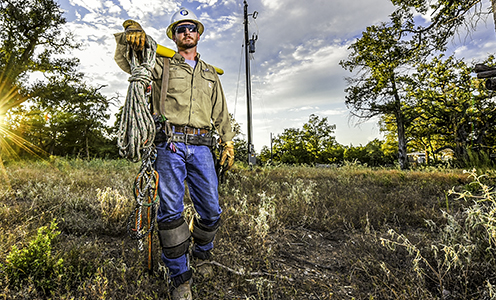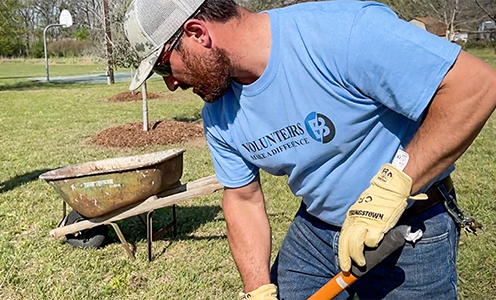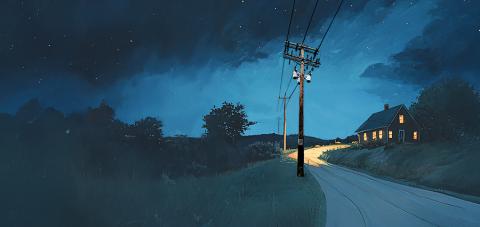Power on
Recent news
By Matt Bentke, General Manager and Chief Executive Officer of Bluebonnet Electric Cooperative
Searing heat arrived in early May and an above-average number of triple-digit days are forecast through the summer of 2018. Extreme temperatures make reliability of the state’s electric grid critically important.
The Electric Reliability Council of Texas, more commonly known as ERCOT, expects to see record-breaking demand for power this summer and estimates there will be enough power to meet that demand. ERCOT is the independent system operator responsible for most of the state’s electric grid.
But population growth and a strong, energy-intensive economy — as well as the retirement of several older, less-efficient coal-fired power plants in the last year — mean that the state’s electricity supply will be tight.
The state’s reserve margin of power is something that concerns everyone from the governor to each utility responsible for generating and delivering power to consumers.
The reserve margin is a safety net in the event that one or more power plants unexpectedly stops generating electricity. If that happens, the reserve margin is intended to ensure there is enough power to meet the state’s needs. ERCOT’s goal is to maintain a 13.75 percent reserve margin, which is about 10,000 megawatts. However, this summer the reserve margin is currently forecast to be 11 percent, about 8,000 megawatts.
One megawatt of electricity provides power to about 200 homes during peak demand, typically between 3 and 7 p.m. on a hot summer day.
Bluebonnet Electric Cooperative works closely with the Lower Colorado River Authority, our primary wholesale power provider, to ensure there is a sufficient supply of reliable energy for our members. We monitor grid conditions 24 hours a day, every day, and will inform members through our website and by traditional and social media if energy conservation efforts are needed.
Consumers can also monitor grid conditions by following ERCOT on Facebook and Twitter, and by downloading its app to mobile devices. ERCOT’s mobile app shows real-time energy demand, capacity and operating reserves. You can also opt in to receive energy conservation alerts on your mobile device during periods of peak demand.
Bluebonnet’s members can conserve energy and reduce peak demand in their homes by setting their thermostats two to three degrees higher, setting programmable thermostats to higher temperatures when no one is at home, using fans to feel four to six degrees cooler, and avoid using large appliances such as ovens, washing machines and dishwashers between 3 and 7 p.m.
Businesses can conserve energy during peak demand hours by using natural rather than electric lighting and shutting down or reducing nonessential production processes.
If energy demand begins to outpace supply, ERCOT will issue emergency energy alerts, which local media outlets will broadcast and we will immediately share with our members. These alerts are intended to reduce demand and prevent interruptions to service.
However, if the state’s operating reserves drop below a critical level, ERCOT will order utilities to begin temporary, rotating power outages. Those temporary outages will be randomly distributed and limited to 20 minutes at a time. The last time Bluebonnet members experienced such temporary outages was February 2011.
ERCOT has consistently done an excellent job of monitoring and managing the state’s electric supply for many years. With its close oversight and every Texan’s help in decreasing power use on summer’s hottest days, we hope to continue to avoid any inconveniences to Bluebonnet members.
By Denise Gamino
GIDDINGS — Beginning in 1924, at age 7, Arnold Smith walked the land in Lee County with an eagle-eye gaze that made him one of the best hunters in Texas.
He wasn’t looking for animals.
He was searching for history.
Some of what he found is 10,000 years old: spear points made by the earliest humans who lived in what is now Texas — Paleo Indians — who hunted prehistoric bison, mammoths and giant ground sloths. Over decades, Smith unearthed thousands of other American Indian artifacts, including arrow points, dart points, knife blades, tools, smoking pipes made of stone and other objects chiseled by hand from native materials.
Much of the more than 2,400 artifacts came from numerous peanut fields that once blanketed much of Lee County. Peanut farmers would tell Smith, “We’re getting ready to plow, so come out and pick up all these dang rocks.”
Over the decades, Smith amassed one of the largest privately owned American Indian artifact collections in Texas. And before he died in 2014 at age 97, his personal obsession became a public collection.
Smith’s artifacts are permanently displayed at the Giddings Public Library and Cultural Center, just a block off U.S. 290. It’s a convenient stop for anyone curious about how ancient people hunted at the end of the Ice Age and how Tonkawa, Comanche and Apache Indians survived on the blackland prairie hundreds of years ago.
“Arnold Smith’s quest for arrowheads and other American Indian artifacts started out as a money-making venture,” the exhibit text states. Smith and his father, Leslie Martin Smith of Giddings, used to lay out lines to fish and then hunt for arrowheads while waiting for the fish to bite. They sold the vibrant-colored arrowheads to dealers, according to the exhibit, and the “extra cash came in handy in the mid-1920s.”
The collection’s curator, professional Indian artifact collector Chad Roesch of Pflugerville, visited Smith many times to learn about the collection. Smith told Roesch, “I was a boy when the Dust Bowl was happening. It wasn’t anything to go out and pick up 100 (arrowheads) a day. Wind was eroding the terrain down pretty quick.”
It is difficult to match one arrow point or artifact in Smith’s collection to one tribe, Roesch said, because American Indians were often nomadic and traded with each other.
“Many times you’ll find an arrowhead in Central Texas that belongs in Oklahoma,” he said. “There are some rare pieces in there.”
As an adult, Smith worked for 36 years as a utility pole digger for Bluebonnet Electric Cooperative. Early on, he had to dig 5-foot or deeper holes by hand. He met many Lee County landowners who let him hunt for Indian artifacts on their property in his spare time, Roesch said.
Smith had good luck finding arrowheads and artifacts around the communities of Manheim, Fedor, Lincoln and Loebau. He also liked to hunt along Rabbs Creek, Paint Creek and West Yegua Creek.
The collection eventually outgrew Smith’s house in Giddings. By the time he donated his collection to the City of Giddings, the arrowheads and artifacts were in frames, shadow boxes, buckets and plastic storage bins in a backyard shed.
“He said for awhile after he retired that he had a few places that he could go to search for artifacts, and he did,” said Pamela Hutchinson, director of the Giddings library. “And then he said, ‘I had so many, I didn’t have any place else to put any more, so I just sat at home.’ ”
“He was a real humble person,” Hutchinson said. “He was so humble he didn’t really recognize the value of what he had in his storage shed.”
On opening day of the Arnold Smith Collection at the Giddings Library in 2003, Smith choked up. “He couldn’t even talk he was so overwhelmed,” Hutchinson said.
Fellow collector Roesch knows about the emotions that come with building a large arrowhead collection. Someone who finds an arrowhead realizes that “no one has touched this since an Indian left this here, and that’s a pretty overwhelming feeling,” he said.
Smith was enthusiastic about sharing his collection with others. He even brought little bags of broken arrowheads to the unveiling ceremony and gave them to children to nurture their curiosity, Roesch said.
The collection at the library “has been a wonderful asset,” Hutchinson said. “It’s famous throughout Texas, and so we’ve had school students come through and tour the collection. And people from all over the United States have come by to visit.
“This is a real big attraction.”
The Giddings Public Library and Cultural Center is at 276 North Orange Street in Giddings. Find out more at giddingspubliclibrary.org.
Story by Sharon Jayson
When he’s on the road again, Willie Nelson has plenty of company. The music legend has spent many nights sleeping in the most famous Texas luxury home on wheels, but now he’s joined by a rapidly growing number of younger people who like to roam.
Click here for digital version.
Central Texas, in particular, is a magnet for the moveable set. The number and size of RV campgrounds has grown, and more are opening to meet the demands of those who like to sleep behind — or on top of — the wheel.
“We have more activity than any other state in terms of new parks,” said Brian Schaeffer, president of the Texas Association of Campground Owners. Texas has more RV retail registrations than any other state, with almost 42,000 in 2017. The Lone Star State has led the nation in RV owners since 2010, when it overtook California, according to Statistical Surveys, a company in Grand Rapids, Mich., which tracks national retail sales.
At the state group’s convention in April, Schaeffer said they estimate there are 550 to 600 RV parks in Texas today, and one-quarter of them are in Central Texas.
Just as the demographics of those enjoying RVs shift and grow, the RV park scene is changing, too. The Bluebonnet Electric Cooperative service area, which covers all or part of 14 Central Texas counties, is at the heart of the boom. New parks have recently opened, and others are under construction or about to break ground. They include Pinewood RV Park in Smithville, which opened in February, and Sunny Oaks RV Park in Bastrop, which opened in mid-March. Construction is scheduled to begin in July on Thousand Oaks RV Park in Paige, which is expected to open in fall 2019.
While the number of RV campers in Central Texas has grown, visits to South Texas and the Rio Grande Valley have decreased, Schaeffer said. The latter have long been winter destinations for older RV-driving retirees — “winter Texans’’ or “snowbirds” — from colder Northern states.
“In the days of old, traditionalists went back to the Valley and they were their own entertainment,” Schaeffer said. “Now, the demographic is more interested in being entertained and finding things to see and do.”
Today’s RV buyers have a more active lifestyle, and their vehicles are increasingly designed for those uses. “They want to take the hunting trip or take their motorcycles or ATVs with them,” said Kevin Broom of the Recreation Vehicle Industry Association.
Now, younger owners — including millennials with young families, and even college students — are getting into what’s known in the industry as camping. Don’t look for any tents, though. These new RV owners stay connected using smart technology 24/7, all while exploring new places and saving money.Workforce flexibility and a healthy economy make the open road even more alluring.
Younger buyers “like the independence and play whatever music they want and cook what they want,” said Phil Elam, executive director of the Texas Recreational Vehicle Association. “They have so many choices, they really have begun to value the RV industry as an option for their entertainment dollar.”
Proximity to Austin and surrounding areas is part of the appeal of Central Texas.
Another sizable segment of RV owners wants to downsize, be minimalist or simply save money. They are putting down roots and turning their rolling homes into permanent residences. Temporary workers make up another demographic. Oil field workers, nurses or educators, for example, may stay in the area for a few months or a year.
Rick and Julie Neff of Alaska enjoy staying in Caldwell County at the Lake Falling Star RV Resort in Dale. It’s home base for their 44-foot Charleston, a luxury motor home they bought new in 2016.
The Neffs say wanderlust inspires them to follow NASCAR races around the country in their RV, even though they still own a 2,600-square-foot home in the community of Eagle River near Anchorage. “We both grew up accustomed to being mobile,” said Rick Neff, who has five sisters in the Bastrop and Smithville area.
Rick Neff has retired twice: in 1994 from the U.S. Air Force, where he worked as a radar technician, and again in 2015, from the Federal Aviation Administration, where he was a maintenance supervisor.
The Neffs’ impressive motor home features a master bedroom with a king-size bed, two bathrooms, five televisions, a washer and dryer, dishwasher, convection oven, standard size refrigerator, electric fireplace and an outdoor chest freezer.
Recreational vehicles are also an alternative to in-demand and high-priced student apartments in San Marcos and surrounding areas. Mason Moore, a sophomore at Austin Community College’s campus in Hays County, just north of San Marcos, bought a 27-foot camper trailer and has lived at the Blind Salamander RV Park in San Marcos for more than two years.
“Moneywise, this is a good option,” he said. “I didn’t really want to live with anybody. This is by far the cheapest way to live by yourself.”
Just as there is a wide variety of RV owners, there is an equal variety of vehicles, in all sizes, styles and prices.
“Buyers are looking for something that feels like home. They want space, and they want it to look nice,” said Paul Krauss, sales manager at Crestview RV on Interstate 35 in Buda, south of Austin. Krauss has been selling RVs for 15 years, and the dealership in Buda has been in business for more than 30 years, he said.
Krauss said the most popular RVs are “bunkhouse travel trailers” that don’t require a truck and have bunk beds to sleep kids.
Recreational vehicles overall “have a more residential look — better cabinets, better countertops, nicer sinks,” he said. “They’re looking more and more like a home every day.”
Customers come to this showroom from across the state, but most live within a 50-mile radius, which includes a large swath of Bluebonnet’s service area.
Krauss said prices range from about $11,900 for a small trailer to well over $300,000 for a top-of-the-line motor home that could include theater seating with heated seats.
While most of this area’s RV parks are independently owned and operated, corporate park ownership is becoming more common across the country, said Schaeffer of the Texas campground owners’ group.
“In the last 10 years, these entities have bought up a bunch of properties in Texas,” he said. “The larger (the parks) are, in terms of number of sites or the revenue they generate, the more they’re acquired by corporate entities. This corporate trend is national but probably hits the Sunbelt states more.”
Kampgrounds of America has more than 500 campgrounds in North America. “We’re a major player in Texas,” spokesman Mike Gast said. “In our directory, we list 24 locations in Texas alone. It’s on par with California, which has 31 and Florida with 21.”
In private RV parks in Texas, daily or weekly guests typically pay an all-inclusive fee for a site and hookups to electricity, sewage, water and cable TV. Those who stay a month or longer are considered extended-stay guests and typically pay a much lower site fee, but are often charged for the electricity they use. Many, but not all, RV parks have sub-metered sites, so guests pay for their power use along with a fee to the RV park for making power available, Schaeffer said.
For example, the daily rate at Sunny Oaks, with all utilities and cable included, is $28 or $30 (depending upon the type of space needed). The weekly rate includes the same options for $175 or $200. Monthly rates are $375 or $400, but electricity is charged separately (including a $150 power deposit).
At Bastrop RV Park, just west of Bastrop on Texas 71, sites aren’t metered and guests pay a flat rate for electricity (based on their vehicle’s amperage). The Bastrop park’s daily rate is $37, including all utilities and cable. The weekly rate is $160 or $180, and long-term guests pay either $460 or $500 a month.
Along with the newer, more mobile RV travelers, many RV parks in the Bluebonnet area are the permanent home for some, including older adults.
Carolyn Norman has lived at Bastrop RV Park for six years. Originally from West Texas, she moved to the area in 2007 to be near family after her husband died. She bought her 29-foot trailer last year, but she has owned others.
“Overall, RV living, to me, is just what I needed,” Norman said. “I wanted something small and where I could see (from) one end to the other. I had been married 52 years, and I hadn’t been alone, and I didn’t want to be by myself.”
Her “neighborhood” at the RV park has several older adults who socialize often, including Sunday breakfasts.
“My son’s here if I need anything,” she said. “But my neighbors, they are so wonderful to me. We get together. We have cookouts. We go out to eat once a week. And if anybody needs anything, we help each other. I really like it.”
For information about RV campgrounds in Texas, go to the Texas Association of Campground Owners, texascampgrounds.com, and the Texas Recreational Vehicle Association, trva.org.
Blind Salamander RV Park
2025 N. Old Bastrop Hwy.
San Marcos
blindsalamanderrvpark.com
OWNERS: Alan and Jennifer Cummings
SPACES: 40
SITE SPECS: 10 acres
HISTORY: The site had been farmland with a few small homes before the RV park was constructed. Alan Cummings’ parents bought the property in 1993, and he and Jennifer bought it from his parents in 2003. It opened in 2009.
WHAT MAKES IT SPECIAL: Easy access to the San Marcos River; near Texas State University
FROM A RESIDENT: “This is by far the cheapest way to live by yourself,'' says park resident Mason Moore, a student at Texas State University.
FROM THE OWNERS: “The other RV parks around us seemed to be full. It seemed like something that would work. We’ve got a few construction folks and quite a few retired people. Maybe 20-25 percent would be students. Most are long-term stay,” says owner Alan Cummings.
Lake Falling Star RV Resort
7355 FM 713
Dale
lakefallingstarrvresort.com
OWNERS: Kelly and Walter Stephens
SPACES: 50
SITE SPECS: 64 acres (including Tinney Lake)
HISTORY: The owners bought Tinney Lake and surrounding land, then started buying the surrounding lots. They opened the RV park in 2006.
WHAT MAKES IT SPECIAL: In addition to outdoor activities at Tinney Lake, there’s a swimming pool and laundry for guests. The clubhouse provides a spot for social gatherings, including scheduled potluck dinners, board games, crafting and quilting.
FROM A RESIDENT: ''We both grew up accustomed to being mobile,” said Rick Neff. He and his wife, Julie, hail from Eagle River, Alaska.
FROM THE OWNERS: “It used to be all retirees traveling,” said Kelly Stephens. “We still have families camping on weekends. But now, we’re seeing more and more people who are not retired that are living in the camper, fifth wheel or motor home as a lifestyle. Austin has gotten so expensive. I’m seeing a lot more families doing this full time. They’re finding this lifestyle a bit cheaper than getting into a house and having to hook up the utilities. If they don’t like something or get transferred, they can just pick up and move.”
Pleasant Grove RV Park
568 Pleasant Grove Road
Elgin
elginrvpark.com
OWNERS: Dorothy Smith (formerly with late husband Charley Smith)
SPACES: 35 SITE SPECS: 21 acres
HISTORY: Dorothy and Charley Smith bought the land in the early 1980s and decided to build on it as a sideline business. He worked for Southwestern Bell and she owned a women’s boutique.
WHAT MAKES IT SPECIAL: A family-owned and operated RV park since 1984; located in a pecan orchard with more than 200 pecan trees.
FROM A RESIDENT: Ken and Debbie Heneise, left, have lived in an RV for 6 years and in Pecan Grove for 2½ years. “Oftentimes we put so much value in our possessions,'' Ken said. “But we’ve learned that when you let go of your ‘things,’ you begin to find the deeper value of life’s experiences.” What does he miss most after downsizing? His collection of books, he said. For Debbie, the hardest thing was living without pets, she said. But cats, like Boots, often just show up and join the family, she said.
FROM THE OWNERS: “In 1984, we decided to try something. We advertised three cabins and cooking facilities and not much of anything else. We sort of felt our way. Eventually, those three cabins we built ended up in storage. We never really intended to have more than probably 12-15 spaces, but as the demand grew, we grew with it,” said Dorothy Smith. Her daughter, Kathy Cannon, runs the business.
Thousand Oaks RV Park (under construction)
U.S. 290 at FM 2104
Paige
OWNER: Bailey Elliott
SPACES: 91
SITE SPECS: 11 acres
HISTORY: Elliott bought the property in March 2017 to develop into an RV park. Construction is planned to begin in July and he expects the park to open in fall 2019.
WHAT WILL MAKE IT SPECIAL: The heavily wooded site will have paved roads with lighting. The park will have a pool, hot tub and barbecue area, as well as a general store, a propane station and a 3,000-square-foot pavilion for gatherings, Elliott said.
FROM THE OWNER: “I’ve got an RV and I love the parks,” said Elliott, right. “Look around Central Texas. All the ones I went to were virtually full, which told me there’s a need for more parks that are nice and a little higher quality.”
Pinewood
RV Park
1256 W. Texas 71 Smithville
pinewoodrv.com
OWNERS: Cody and Stacy Mauck are co-owners with family members Cammey and Clinton Burns
SPACES: 60
SITE SPECS: 10 acres
HISTORY: The owners bought the former Toad Hollow RV Park and closed it in January 2017. Since then, they constructed a new RV park and opened in February under the new name.
WHAT MAKES IT SPECIAL: Although it was previously an RV park, the owners did a “total overhaul” and took more than a year to construct it.
FROM THE OWNERS: “It’s a different way of life — almost like this minimalism that’s big in Austin. This is another step in that direction,” Cody Mauck said.
Sunny Oaks RV Park
744 Texas 95 North
Bastrop
sunnyoaksrvpark.com
OWNERS: Dusty Farrell, in a limited partnership with his brother, David Farrell
SPACES: 60
SITE SPECS: 8 acres
HISTORY: The owners bought the property in 2003 and built a rental house there. Construction on the RV park began in mid-2017. Today, the office building for Sunny Oaks sits on land once occupied by a fireworks store.
WHAT MAKES IT SPECIAL: It’s the first RV park the Farrell brothers have owned, but they’ve studied the business a long time.
FROM THE OWNERS: “An RV park is much simpler than residential duplexes and houses because there are hardly any structures to maintain. It’s a lot simpler because the tenants are mobile,” Dusty Farrell said.
Bastrop RV Park
689 Texas 71
Bastrop
rvtexas.net
OWNERS: Barb and Paul Pape (who is also Bastrop County Judge)
SPACES: 120
SITE SPECS: 25 acres, including 8-10 acres serving as pasture for animals
HISTORY: The Papes bought an RV and mobile home park in 1984 called By the Way Campground, which was about half the size of the current site. The owners changed the name in the early 1990s.
WHAT MAKES IT SPECIAL: The RV Park is the permanent home for a group of widows and widowers.
FROM A RESIDENT: ''We get together. We have cookouts. We go out to eat once a week. And if anybody needs anything, we help each other. I really like it,” said Carolyn Norman.
FROM THE OWNERS: “They will get together and have cookouts at their RV sites. They look out for each other. They walk each other’s dogs. This is a community and this is their home,” said Barb Pape.
A team of Bluebonnet Electric Cooperative line workers — journeymen and apprentices — will once again compete against their peers from across Texas in the 22nd annual Texas Lineman’s Rodeo on July 21 at Nolte Island Park near Seguin. The linemen will compete in a variety of timed events that mirror much of the work they do daily: climbing poles, repairing power lines and working on equipment. There is even an event involving a pole-top rescue of a mannequin the size and weight of an injured lineman.
Apprentices also take a written test, and there’s a competitive barbecue cook-off.
Bluebonnet plans to send one journeyman lineman team, eight apprentices, six judges, one barbecue team and numerous other volunteers. The competition takes place in a Guadalupe River-bottom field studded with non-energized utility poles.
The public is welcome to attend. Come cheer on Bluebonnet’s teams in person or keep track of their progress via Bluebonnet’s social media coverage throughout that day. For more information, visit tlra.org.





